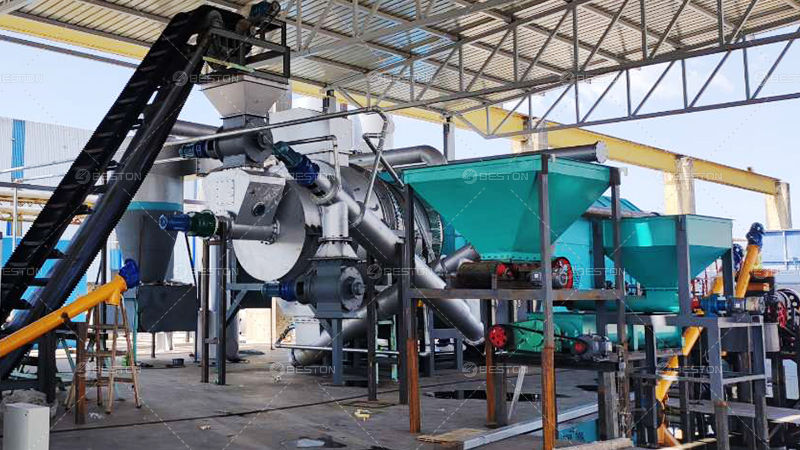Comparing the Carbonization Process of Wood and Rice Husk
- arbourz
- Jul 20
- 4 min read
The carbonization of biomass materials, such as wood and rice husk, involves the thermal decomposition of organic matter in the absence of oxygen. This process, typically carried out in a pyrolysis plant, yields valuable products like biochar, syngas, and bio-oil. While both wood and rice husk can be used for carbonization, the properties of these materials result in significant differences in the process and the final products. Understanding these differences is essential for optimizing the efficiency of pyrolysis operations and maximizing the economic benefits of biochar production.
Material Characteristics and Their Impact on Carbonization
Wood
Wood is a lignocellulosic material composed primarily of cellulose, hemicellulose, and lignin. These organic polymers influence the thermal decomposition process in distinct ways. Lignin, in particular, is highly resistant to decomposition, requiring higher temperatures for effective carbonization. When wood is subjected to pyrolysis, the decomposition of cellulose and hemicellulose produces volatile gases, while the lignin remains largely intact, contributing to the formation of a more solid biochar.
The carbonization of wood typically occurs at higher temperatures (around 400-600°C) compared to rice husk. Wood’s denser structure also leads to slower heat transfer in wood charcoal making machine, which can increase processing time. The final product, wood biochar, is often denser and has a higher carbon content than biochar produced from rice husk.

Rice Husk
Rice husk, on the other hand, is a byproduct of rice milling, consisting primarily of silica and lignocellulosic components. However, the cellulose content in rice husk is lower than that of wood, and it contains a higher proportion of silica, which affects the carbonization process. During pyrolysis, the silica acts as an inert material, reducing the overall yield of biochar. In contrast, the lower cellulose content leads to a quicker release of volatile gases, which means rice husk can be carbonized at lower temperatures (350-500°C).
The physical structure of rice husk is also much lighter and more porous compared to wood, which influences both the rate of heat transfer and the properties of the final biochar. The biochar produced from rice husk carbonizer tends to have a lower density and a higher surface area, which can make it more suitable for applications in soil amendment and filtration, but less stable for long-term carbon sequestration compared to wood biochar.
Differences in Pyrolysis Conditions and Outputs
Pyrolysis Temperature
As mentioned, wood generally requires higher pyrolysis temperatures than rice husk to achieve optimal carbonization. This is because the higher lignin content in wood requires additional energy to break down. In a pyrolysis plant, this means that the temperature control for wood pyrolysis needs to be more precise to prevent the release of excessive volatile compounds that could lead to inefficient fuel production.
Rice husk, with its lower cellulose content, decomposes more readily at lower temperatures. However, the high silica content can cause challenges in pyrolysis, as silica can trap heat and limit the breakdown of organic matter. This leads to a relatively lower yield of biochar and a higher yield of volatile gases compared to wood pyrolysis.
Biochar Yield and Quality
The biochar produced from wood typically has a higher carbon content, making it more stable for long-term soil carbon sequestration. Wood biochar is denser and has a more uniform structure, which can be advantageous for certain agricultural applications, such as improving soil water retention and promoting plant growth.
In contrast, rice husk biochar tends to have a higher surface area and porosity, which makes it ideal for uses in filtration, adsorbing pollutants, or as a precursor for activated carbon. However, its carbon content is generally lower, and the presence of silica can reduce its stability in soil over the long term. Rice husk biochar is often used for shorter-term applications or in contexts where its adsorption properties are more important than long-term carbon sequestration.
Syngas and Bio-Oil Production
The production of syngas (a mixture of gases like methane, carbon monoxide, and hydrogen) and bio-oil also differs between wood and rice husk pyrolysis. Wood, with its higher cellulose content, tends to produce a larger quantity of volatiles, which can be condensed into bio-oil. In contrast, rice husk pyrolysis produces more syngas, which can be used as an energy source to fuel the pyrolysis process itself or be converted into electricity.
The syngas produced from rice husk pyrolysis is typically rich in carbon monoxide and hydrogen, making it an excellent candidate for use in energy generation. The bio-oil from wood, on the other hand, is often more valuable in terms of its chemical composition, with potential applications in the production of biofuels and chemicals.
Energy Efficiency and Process Optimization
Due to the differences in their composition, wood and rice husk require different levels of energy input for pyrolysis. While both materials can be processed efficiently in a pyrolysis plant, optimizing energy consumption is key. Wood, requiring higher temperatures for carbonization, consumes more energy during the pyrolysis process. Conversely, rice husk’s lower processing temperature makes it more energy-efficient but often results in lower biochar yields.
To optimize the pyrolysis process, it is essential to adjust the operating conditions, such as the temperature, pressure, and heating rate, based on the feedstock. Advanced pyrolysis technologies, including fluidized bed and rotary kiln systems, can help maintain consistent temperatures and optimize the decomposition of both wood and rice husk.









Comments